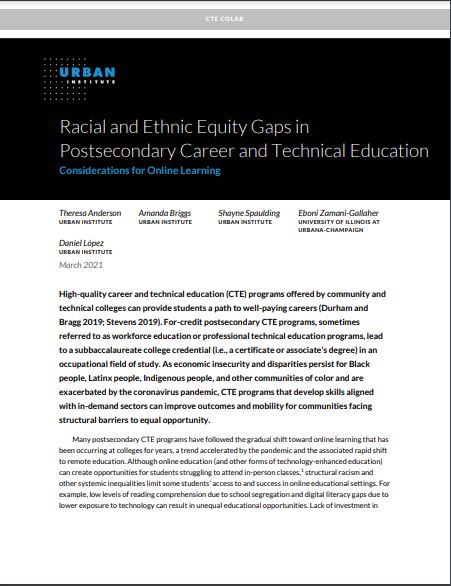Through the CoLab survey, literature review, administrative data, and research, the report identifies the following findings and recommendations that may have implications for gaps in evidence about equity in CTE. Such gaps include improving data and tracking, understanding effective strategies to expand equity, and examining accreditation, licensing and funding policies. Among the many strategies identified through this study, the authors offer the following strategies for online and hybrid learning environments to help CTE programs to become equity conscious:
- Ensuring that students can access technology, software, and internet resources necessary for success.
- Providing students appropriate supports, including academic and technological assistance, for remote learners at times that make sense for their schedules.
- Providing instructors with appropriate and ongoing professional development and sufficient time to prepare them for teaching online with an equity focus, then providing technical assistance as issues arise.
Research also demonstrates the importance of designing technology tools and course programming to improve student engagement and remove inherent bias and can include:
- Synchronous instruction requires students to join lectures or class activities virtually simultaneously with their instructor as if they were attending an in-person class.
- Asynchronous instruction has lower barriers to entry because students can engage with course content on their own schedules. Yet, they may be less supported in their learning without additional opportunities for connection.
- A Blendflex model allows students to choose whether to engage with content in real-time (synchronously) or after the fact (asynchronously). However, it can be expensive or complex for colleges and instructors to implement.
Equity conscious strategies for colleges providing to students of color access to high-quality programs with solid labor market prospects can include:
- Examining recruitment and admission practices.
- Creating meaningful on-ramps that allow different types of students to access CTE programs, such as through dual-enrollment programs with adult education.
- Assessing program cost, including accumulated debt, to improve affordability.
- Reviewing advising that students receive when deciding on a program of study.
- Providing career mentoring to help students “see” themselves represented in different fields of study.






